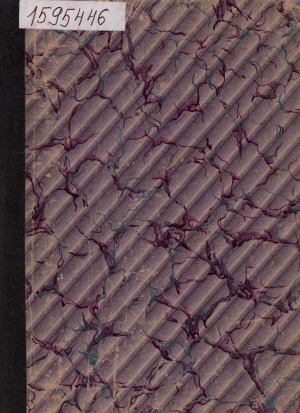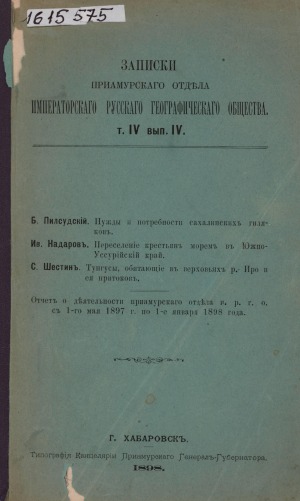- Книга (1379)
- Журнал (9)
- Автореферат диссертации (65)
- Изоиздание (36)
- Аудиоиздание (27)
- Видеоиздание (86)
- Неопубликованный документ (3)
- Нотное издание (3)
- Фотография (12)
- Статья (442)
- Библиографический указатель (15)
- Словарь (2)
- Календарь (1)
- Брошюра (27)
- Буклет (13)
- Электронное издание (2)
- 3D-модель (24)
- Грампластинка (5)
- Веб-архив (511)
Год выпуска: 2019
Статья посвящена рассмотрению возможности применения хорошо известной этнографам, историкам, культурологам, социологам концепции бинарных оппозиций французского ученого Клода Леви-Стросса (1908–2009) для кросс-культурного исследования этнических особенностей использования энергии "горячими" индустриальными и "холодными" традиционными обществами на российском Севере в XVIII–XXI веках. "Горячие" общества стремятся контролировать энергию, постоянно увеличивая ее производство, потребление, а также связанные с этими процессами объемы информации и знаний. "Холодные" общества стараются ограничиться воспроизводством уже давно открытых предками, устоявшихся технологий системы жизнеобеспечения, сохранения традиционных условий своего самобытного существования. Соседство переселенческих и коренных народов в северных регионах на протяжении нескольких веков неизбежно приводит к контактам и взаимообмену культурными ценностями, в том числе и в сфере потребления энергии. Однако до сих пор остается окончательно нерешенной проблема выбора оптимального пути использования энергии в суровых климатических условиях
Год выпуска: 2019
В статье рассматриваются три знаковых инновации, которые появились в культуре неоседлых эвенов Магаданской области за последние 80 лет: нарты (1930-е годы), оленегонные собаки (1940–50-е годы) и трактора (1960‑1970-е годы). Прослеживаются причины и истоки этих заимствований, а также вызванный ими системный кумулятивный эффект. Активные инновации были связаны с адаптацией эвенов-оленеводов к природной и этнической среде, начавшиеся с их выхода на территорию Северо-Востока. Форсированные инновации были вызваны влиянием государства, поставившего целью перевести часть кочевников на оседлость, а также вкладывавшего значительные ресурсы и энергию в модификацию оленеводства как отрасли сельского хозяйства. В результате адаптации к реалиям постсоветской экономики вновь появилось большое разнообразие локальных вариантов культуры, усложненной заимствованиями и привязанной к матрице государства, однако сохраняющей запасные варианты на случай отказа технологических устройств. Инновации рассматриваются в статье, с одной стороны, как следствие процессов пересечения разных темпоральных режимов в результате этносоциальных контактов и влияния государства, а с другой, как механизм культурного сдвига
Год выпуска: 2019
В статье рассмотрены параметры обмена ресурсами в поселке на р. Лена в Северной части Якутии. Основная цель работы — это прояснение феномена обмена через исследование особенностей выстраивания социально-культурного пространства посредством обменных практик. В качестве предмета исследования выступает феномен обмена, локализованный в конкретном контексте его функционирования. Работа основана на материалах, собранных автором в ходе экспедиции 2018 г. В первой части статьи определяется проблема исследования, кратко описываются основные теоретические разработки, применяемые в статье либо оказавшие влияние на характер рефлексии автора по поводу данного материала. Далее следует описание социально-культурных компонентов, оформляющих обменные практики; произведено "рассеивание" общего контекста поселка на отдельные группы элементов, объединенные (лишь потенциально) функциональной связью с феноменом обмена. Также рассмотрены примеры "контекстов", складываемые из этих элементов и отражающие их различные связки: в сфере промыслов, торговли, кормления духов, народных праздников и др. В заключительной части формулируются основные взгляды и выводы автора по поводу исследуемой проблемы: социально-культурное поле обменов представляется континуумом отношений, материальных (живых и неживых) объектов, их поведением, свойствами и пр., что требует особого "инструмента" для работы с ним. Такими Һинструментамиһ, по мнению автора, выступают концепты "сгущения", "уплотнения", "развязывания" и т. п., поскольку в непрерывном поле отношений обмена они позволяют производить фиксации центров "сгущений" определенных параметров, указывающих на специфику обменных процедур. Сделан вывод о "внекультурном" актуальном свойстве акта коммуникации в форме обмена, обозначен его связывающий потенциал. Через структурный анализ обмена в общем виде сделан вывод о ресурсной асимметрии, провоцирующей обмен, дано определение обмену. Выводы могут быть применены к анализу энергетических потоков в социокультурной среде
Год выпуска: 2016
Статья посвящена анализу сюжетного материала и структуры долганских сказок. Авторы считают, что северный фольклор является не только частью самобытного устного творчества коренных народов, но и важной составляющей в формировании этнической идентичности. В связи с этим изучение сюжетов позволит понять особенности северной культуры долганского народа, выявить структуру и устройство сконструированного в сказках мира
Год выпуска: 2018
Данная публикация посвящена 60-летию известного ученого-тунгусоведа Т.Ю. Сем. В статье описывается вклад Т.Ю. Cем в этнографическую науку, приводится список основных трудов ученого
Количество страниц: 15 с.
Dobzhanskaya, O/ E. The Living Has Sound. The Dead Is Silent / Oksana E. Dobzhanskaya ; Moscow State University // Anthropology & archeology of Eurasia. - 2016, Т. 55, N 1. - С. 7-21. - DOI: http://dx.doi.org/10.1080/10611959.2016.1263485
DOI: http://dx.doi.org/10.1080/10611959.2016.1263485
Издательство: Типолитография Иосифа Корот
Год выпуска: 1918
Количество страниц: 30 с.
Издательство: Типография Канцелярии Приамурского Генерал-Губернатора
Год выпуска: 1898
Количество страниц: 134 с.
Год выпуска: 2018
В 1997 и в 2017 годах в Эвенкии были проведены комплексные исследования по современным этническим процессам с использованием метода массового опроса. Выявлены существенные изменения в хозяйстве, в разных областях материальной и духовной культуры. Резко снизилось значение оленеводства, в настоящее время в нем заняты около 1/10 части эвенкийских семей. Лучше сохранились охота и рыболовство, в них занята почти треть мужчин. На любительском уровне охотой и рыболовством занимается подавляющее большинство мужчин, а значительная часть женщин не утеряли навыков шитья и вышивки бисером. Активно идет процесс языковой ассимиляции, дети практически не говорят на языке эвенков и не понимают его, хотя большинство эвенков изучает родной язык в школе. Количество национально-смешанных семей, в основном с русскими, приблизилось к половине всех семей, большинство детей вливаются в эвенкийский этнос. В результате этих браков доля метисов среди эвенков приближается к 2/3, а среди детей их доля достигла 9/10. Эвенки превращаются в группу русскоязычных метисов, но с устойчивым этническим самосознанием и с сохранением элементов традиционной культуры в некоторых областях материальной и духовной культуры
Год выпуска: 2022
Целью и задачами статьи является выявление основных способов перевода на русский текста якутского героического эпоса олонхо "Ала-Булкун", осуществленного якутским лингвистом и писателем Г.В. Баишевым-Алтан-Сарын (1898-1931). В качестве материала исследования были выбраны глаголы движения и некоторые основные эпические формулы, использованные в данном олонхо. Анализ способов перевода на русский язык якутских глаголов движения показывает, что эти глаголы переведены на русский язык способом замены. Подобный факт свидетельствует о том, что переводчик стремился точно передать семантику якутских глагольных форм на русский язык. Это, свою очередь, обусловлено тем, что глагольные формы как предикативные структуры являются вершинами тех или иных предикативных конструкций – зависимых или независимых. Эпические формулы переведены при помощи синтаксической замены – параллелизмами, а также расчленением предложения на несколько предложений. Кроме того, встречаются лексические и синтаксические повторы для расширения контекста с целью более медленного раскрытия передаваемой информации. Установлено, что в рассмотренном переводном тексте имеют место элементы авторизованного перевода. Изучение особенностей подобных переводов олонхо, ориентированных на воспроизведение стилистических и поэтических особенностей данного жанра якутского фольклора, имеет как практическое, так и теоретическое значение









